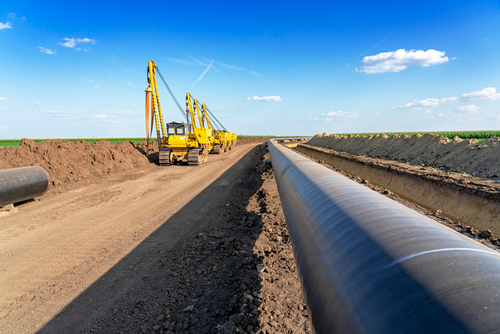TUESDAY, MARCH 17, 2020
Recently, Canadian pipeline company TC Energy Corp. announced that it had officially began preliminary work for pipeline construction slated to take place along the border’s crossing into Montana.
Groundbreaking for the construction is expected to commence next month.
Keystone XL Pipeline History
In 2011, the $5.2 billion pipeline began flowing crude oil through seven U.S. states, where it will eventually work in tandem with the $8 billion Keystone XL Pipeline. The Keystone Pipeline as a whole is reported to handle up to 23 million gallons of crude oil daily.
In 2017, President Donald J. Trump’s administration reversed his predecessor’s decision on the construction of the Keystone XL pipeline, allowing the 1,179-mile oil pipeline to move forward again. Keystone XL, a project of TransCanada, is part of the larger Keystone system and plans to transport oil from Hardisty, Alberta, in the western Canadian oil sands, to Steele City, Nebraska.

 |
| RGtimeline / Getty Images |
|
Recently, Canadian pipeline company TC Energy Corp. announced that it had officially began preliminary work for pipeline construction slated to take place along the border’s crossing into Montana. |
In April 2018, TransCanada revealed that approximately 9,700 barrels of oil spilled on farmland in Marshall County, South Dakota, on Nov. 16, 2017—considerably more than the 5,000 barrels the company originally estimated were lost.
Preliminary reports indicated that the leak may have come as a result of damage to either the pipeline itself or its protective coating, caused during construction 10 years ago. The Aberdeen News noted that if the current estimate is correct, that spill is the seventh largest in the U.S. since 2010.
By July, officials confirmed at least one section of the pipeline north of Britton, South Dakota, was being dug up for inspection. A year later, a federal report indicated that improper coatings were likely used on the pipeline. The Pipeline and Hazardous Material Safety Administration issued a notice of probable violation to pipeline owner TC Oil Operations, also known as TC Energy, in mid-June.
Another incident occurred this past November, causing over 380,000 gallons of oil to leak from the Keystone Pipeline, a total amounting to 9,120 barrels of crude oil. Sections of Keystone pipeline were shut down in response to the leak, which impacted a wetland area and, at the time, an estimated 2,500 square yards of land. TC Energy, formerly known as TransCanada, said that air quality, wildlife and environment monitoring was being conducted.
While the cause of the leak underwent investigation, North Dakota regulators also noted that drinking water supplies went unaffected, and TC Energy reported that the spill had been contained, and that it was using backhoes and vacuum trucks to recover the spilled oil.
The pipeline officially returned to service on Nov. 10, after receiving approval for a repair and restart plan by the U.S. Pipeline and Hazardous Materials Safety Administration.
However, at the end of the same month, North Dakota environmental scientist Bill Suess, the estimated amount of land affected by the oil spill had risen nearly 10 times the original estimate, although the amount of oil leaked remained the same.
During collection, the contaminated soil was stockpiled and taken to a landfill in Sawyer, North Dakota.
Earlier this year in January, TC announced through a status report filing at the U.S. District Court in Montana that the company would kick off pre-construction efforts as early as February.
“This is very good news for Canada as a country,” said Tristan Goodman, President of the Explorers and Producers Association of Canada, which represents small- to mid-sized oil and gas producers. “It’s extremely good for Alberta and Saskatchewan, where a lot of the oil for this is coming from.”
What’s Happening Now
According to TC Energy spokesperson Sara Rabern, the company had already begun moving equipment to worksites last week when the announcement was first made and intends to begin mowing and felling trees along the pipeline’s 1,200-mile-long route within the next week or so.
Thus far, preparation work is slated to take place in Montana, South Dakota and Nebraska.
However, the company is still waiting on U.S. District Judge Brian Morris’ ruling, which will decide if any work on the project will be blocked. The motion to halt the work was previously made in January by environmentalist groups after the Trump administration approved a right-of-way allowing for the pipeline to be constructed across federal land.
“It is irresponsible for TC Energy to jump the gun before Judge Morris rules on our motion,” said Stephan Volker, an attorney for the Indigenous Environmental Network and North Coast Rivers Alliance.
If cleared for construction, the $8 billion pipeline will transport up to 830,000 barrels of crude oil daily from western Canada to terminals on the U.S. Gulf Coast.
In addition to the project update, TC Energy has also announced via press release that its wholly owned subsidiary, NOVA Gas Transmission Ltd. (NGTL), has executed an exclusive letter of intent with Tidewater Midstream and Infrastructure Inc. and TransAlta Corporation to purchase the Pioneer Pipeline for $255 million.
The Pioneer Pipeline is an operational 131-kilometer-long (roughly 81-mile-long) pipeline that runs from Alberta and runs from west of Drayton Valley to west of Edmonton. Once acquired, the pipeline will be integrated into the NGTL System.
The acquisition is underpinned by 15-year firm delivery contracts for 328 million cubic feet per day (mmcf/d) and an eight-year firm receipt contract for 47 mmcf/d. The purchase is subject to execution of definitive agreements, which are expected to occur in the second quarter of 2020, and will require approval from the Canadian Energy Regulator.
Tagged categories: Infrastructure; Infrastructure; Oil and Gas; Ongoing projects; Pipeline; Pipelines; Program/Project Management; Project Management; Upcoming projects